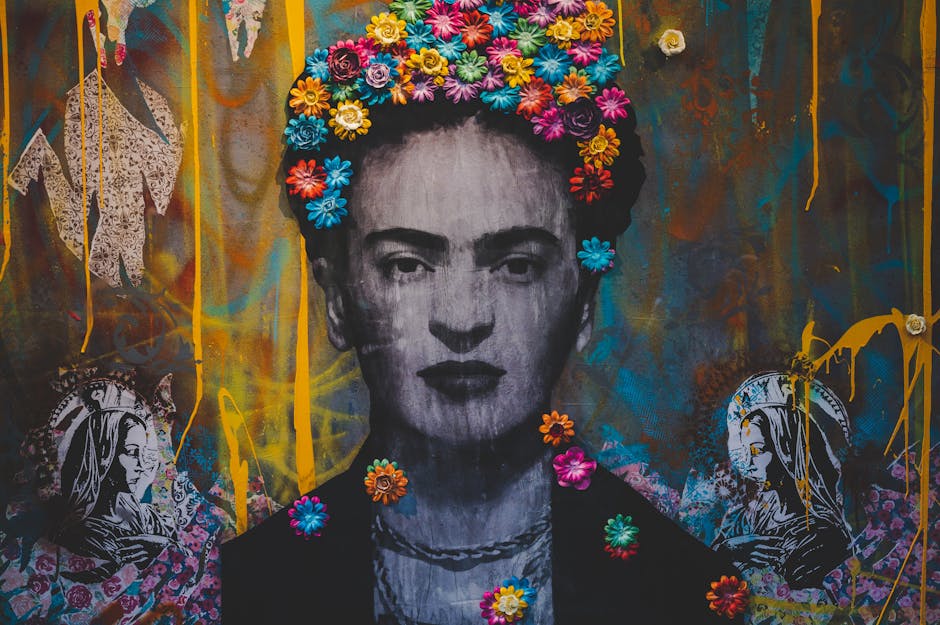Defying Gender Norms and Beauty Standards
Frida Kahlo challenged gender stereotypes and beauty norms through her appearance and art. Her monobrow and faint mustache, which she emphasized in her paintings, made a statement about the arbitrary nature of beauty. In family portraits, Frida chose to wear suits instead of dresses, rejecting narrow gender roles.
Kahlo also made waves with her traditional Mexican attire. She wore Tehuana dresses with billowing skirts and embroidered blouses to highlight her Mexican roots and make political statements. These outfits celebrated indigenous artistry and female strength.
Frida's fashion and physical appearance reflected her inner world and challenged societal norms. Through her choices, she showed that:
- Femininity and masculinity could coexist
- Beauty was more than skin deep
- Clothing could be a canvas for political expression
Her life was a bold statement of defiance and individuality.
Exploring Female Experiences in Art
Frida Kahlo's artwork was a raw exploration of female experiences often ignored by society. Through her paintings, she depicted deeply personal and painful aspects of womanhood—miscarriage, abortion, breastfeeding.
Her painting "Henry Ford Hospital" lays bare the agony of her own miscarriage. It features Kahlo lying on a hospital bed, surrounded by symbolic objects. The graphic depiction forces viewers to confront the visceral reality of what many women experience.
"My Birth" is another jarring example, depicting the moment of delivery with a baby crowning. It's an unflinching look at childbirth from a woman's perspective, contrasting with idealized depictions.
These weren't just theoretical exercises; they reflected Frida's lived reality. She painted what she knew—the blood, the tears, the undeniable struggle. Her works defied social norms of her era when such topics were deemed too unseemly for public discussion.
By turning the canvas into a space of emotional and physical authenticity, Frida Kahlo established herself as a powerful feminist icon. She offered a voice to those quieted by societal taboos and showed that women's experiences matter—every tear, every drop of blood, every single brushstroke.
Queer Identity and Sexual Liberation
Frida Kahlo's embrace of her bisexuality in the early 20th century was revolutionary. She wove her queer identity into her life and art, treating it as another facet of her multi-dimensional persona. Throughout her marriage to Diego Rivera, she engaged in relationships with both men and women, including notable figures like Josephine Baker and Chavela Vargas.
In a society that ostracized non-heteronormative relationships, Frida's openness about her sexual fluidity was groundbreaking. She painted her lovers within her artwork, allowing viewers a glimpse into her world free from societal inhibitions. Her piece "Two Nudes in the Forest" depicted two nude women in an intimate embrace, an open celebration of lesbian love.
Frida's sexual relationships illustrated her philosophy on love—one that saw openness and freedom as essential components. She and Diego Rivera each had extramarital affairs, embodying a complex, polyamorous dynamic that spoke to her modernity.
Her adventurous love life resonated beyond the art world, encouraging women to claim their sexual agency and embrace their desires without shame. This advocacy for sexual freedom was intertwined with her broader feminist ethos, advocating for a world where women could live uninhibited.
"I used to think I was the strangest person in the world, but then I thought there are so many people in the world, there must be someone just like me who feels bizarre and flawed in the same ways I do."
Frida Kahlo's legacy persists not only through her art but through her audacious spirit. She demonstrated that one's identity could be rich, layered, and fluid, and that embracing all facets of oneself was not only possible but a form of resistance.

Resilience and Defiance Against Victimization
Frida Kahlo's life was a testament to resilience and defiance. Her journey with polio at a young age and a catastrophic bus accident in her teens were just the beginning of her physical and emotional battles. Yet, it was in these darkest moments that her creativity flourished.
The bus accident at 18 shattered her spine, broke her pelvis, and left her with chronic pain. Confined to bed for months, Kahlo began to paint, using an easel her mother had made for her. Her art became a sanctuary and an outlet for her intense physical and emotional turmoil.
Her paintings from this period transformed personal suffering into universal experiences. "The Broken Column" depicts her with a split torso, her spine represented as a crumbling ionic column. This artwork is not just a portrayal of her physical pain; it's a statement of resistance against being solely defined by it.
Kahlo's ability to rise above her limitations, painting through her pain, and embracing her scars was a form of rebellion. Her defiance was a rejection of the victim narrative—an assertion that, despite her broken body, her spirit was unbreakable.
Even while grappling with chronic pain, Frida continued to:
- Create art
- Attend political rallies
- Live passionately
Her ability to endure and create in the face of constant suffering turns her story into a bold declaration of feminist strength.
In the end, Frida Kahlo's story is one of triumph. She taught us that it's possible to rise, to paint beauty from pain, and to forge an identity that defies limitations. Her journey stands as a powerful reminder that resilience is a mark of true feminist power.
- Herrera H. Frida: A Biography of Frida Kahlo. Harper Perennial; 2002.
- Kahlo F, Lowe SM. The Diary of Frida Kahlo: An Intimate Self-Portrait. Abrams; 1995.
- Ankori G. Imaging Her Selves: Frida Kahlo's Poetics of Identity and Fragmentation. Greenwood Press; 2002.

























